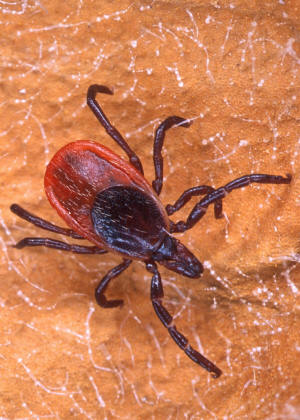|
 Prevent
Tick-Borne Diseases While Enjoying the Outdoors Prevent
Tick-Borne Diseases While Enjoying the Outdoors
By Melinda Myers
 Send a link to a friend
Send a link to a friend
[June 17, 2019]
You’ve
grabbed your water bottle, sunscreen and hat for a hike in the park
or some gardening. Add a bit of tick protection to your must-have
items when you head out the door for an adventure, to garden or
play.
|
|
 Continue enjoying the outdoors by enlisting a
variety of strategies to limit your risk of exposure to ticks and
the disease pathogens they transmit. Here are just a few of the ways
to increase your safety and enjoyment. Continue enjoying the outdoors by enlisting a
variety of strategies to limit your risk of exposure to ticks and
the disease pathogens they transmit. Here are just a few of the ways
to increase your safety and enjoyment.
Wear light colored clothing to more easily spot the tick before it
moves onto your skin. Wear long pants and tuck them into your socks
and tuck your shirt into your pants. Ticks often gain access through
pant legs or shirttails and crawl up looking for a place to settle
in and feed.
Consider spraying your clothing with an insecticide labeled for
repelling and killing ticks. Spray your clothing and let it dry
before wearing. Or invest in pre-treated clothing for gardening,
hiking or other outdoor activities. Read and follow label directions
carefully.
Always conduct a tick check on yourself, children and pets after
spending time outdoors. Studies show that regular tick checks are
the most effective way to prevent diseases transmitted by ticks.
Ticks can feed anywhere but are often found in and around the ears
and hair, inside the bellybutton, under the arms, around the waist,
back of the knees and between the legs.
Check your clothing inside and out. Ticks can survive for several
days in the house and even when washed in warm or hot water. An hour
in the dryer on high heat will kill them.
Shower within two hours after spending time outdoors. The water can
help dislodge any unattached ticks plus this provides a second
opportunity to conduct a tick check. Studies found this practice
greatly reduces the risk of tick-borne diseases.
Manage your landscape to reduce the tick population. Keep the grass
mowed and remove brush, groundcovers, firewood piles and birdfeeders
near the home or where the family frequents. Keep swing sets away
from the woods and placed on woodchip mulch. Eliminate invasive
barberry, honeysuckle and buckthorn that create a tick-friendly
habitat.

[to top of second column] |

Many of us are doing the opposite. We are eliminating
lawns, increasing groundcover, planting more trees, shrubs and
flowers to create more diverse wildlife-friendly habitats. There is
limited evidence that increasing animal diversity may help reduce
the rate of tick associated diseases. Unfortunately, the fragmented
woodlands and ecosystems do favor deer and white-footed mice that
are key to the maintenance and transmission of tick-borne diseases.

Consider creating a tick safe zone area where your family frequents
and limit your time in tick infested areas. Widen pathways, prune
trees to increase light, exclude deer and discourage rodents to
reduce the risk of exposure.
And if additional control is needed to create a tick
safe zone, consider using a pesticide like Summit Tick & Flea Spray
that contains permethrin. You’ll only need small amounts at the
right time of the year for effective control. One application in
spring or fall is usually sufficient for managing the ticks that can
transmit Lyme disease. For the dog tick, also known as wood ticks,
an application can be made anytime after the adults emerge. As
always read and follow label directions.
Make these practices part of your routine so you and your family can
continue to safely enjoy all your favorite outdoor activities.
Melinda Myers has written more than 20 gardening books, including
Small Space Gardening. She hosts The Great Courses “How to Grow
Anything” DVD series and the nationally-syndicated Melinda’s Garden
Moment TV & radio program. Myers is a columnist and contributing
editor for Birds & Blooms magazine and was commissioned by Summit
for her expertise to write this article. Myers’s web site is
www.melindamyers.com.
[Photo credit: Scott Bauer, USDA ARS,
Bugwood.org] |